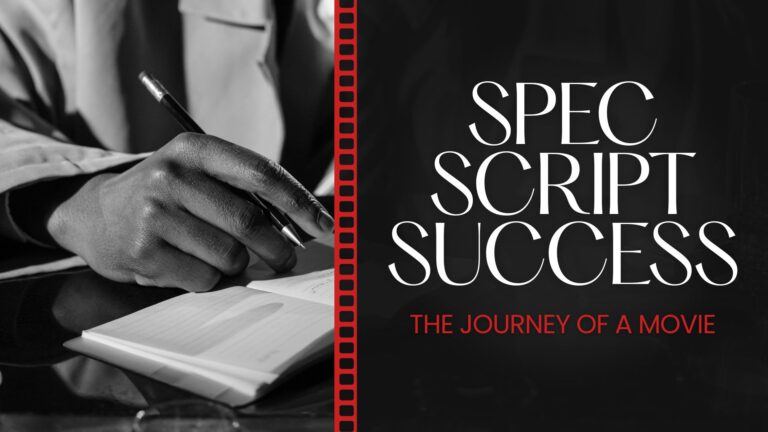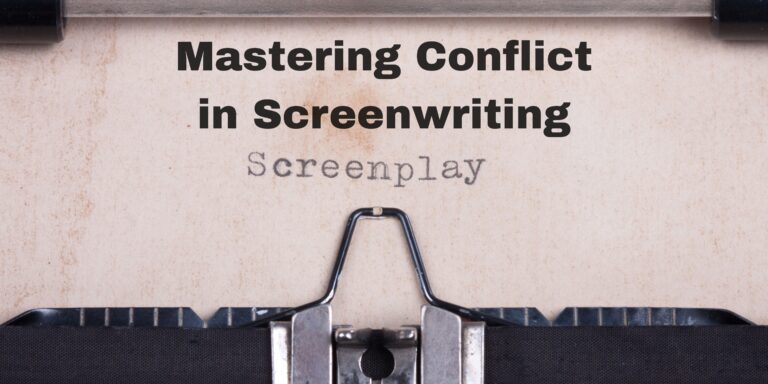Sci-Fi Screenplay Tips: Make Worlds Feel Real
In the vast galaxy of storytelling, imagination is your spaceship, but realism is your gravity. The best Sci-Fi screenplay tips don’t just teach you to invent planets or design laser-firing gadgets; they show you how to make those worlds feel lived in.
After all, a Sci-Fi story without grounded worldbuilding is like a rocket without fuel; it might look sleek, but it’s not going anywhere.
Think about the universes that have stuck with you: Star Wars, The Matrix, Blade Runner. Each isn’t just dazzling tech or far-flung futures; they pulse with human emotion, cultural rules, and everyday logic that make the impossible feel possible.
That’s the golden thread of worldbuilding, it bridges imagination and believability, making your script soar beyond spectacle into substance.
These sci-fi screenplay tips will help you turn your cinematic dreams into worlds audiences can taste, touch, and believe in. You’ll learn why worldbuilding isn’t a luxury; it’s the lifeblood of every unforgettable sci-fi script.
So buckle up; the journey ahead won’t just take you to new worlds, it’ll teach you how to make them real enough to breathe.
Why Worldbuilding Makes or Breaks a Sci-Fi Script
Every screenwriter dreams of crafting a universe that leaps off the page. But here’s the truth: without solid worldbuilding, even the most imaginative story will collapse like a star gone supernova.
One of the most essential sci-fi screenplay tips is understanding that worldbuilding isn’t just scenery, it’s structure. It’s the oxygen that gives your story life.
In screenwriting, worldbuilding means constructing the ecosystem of your story, its geography, culture, rules, technology, and moral compass. It’s how you decide what’s possible, what’s forbidden, and what happens when someone dares to break those boundaries.
Great worldbuilding makes your story immersive; poor worldbuilding pulls viewers out faster than a bad CGI shot.
What Worldbuilding Really Is
At its core, worldbuilding is the art of imagining, designing, and implementing the world where your story unfolds. Think of it as laying the bricks of an invisible city, one that the audience feels long before they see it.
Good worldbuilding often hides in plain sight; you feel its presence rather than notice it directly.
Read more: Mastering Conflict in Screenwriting: Unleash Magnetic Screenplay Tension
There’s no single way to approach it. Some writers start from the top down, sketching maps, setting cosmic laws, or designing futuristic tech. Others work from the ground up, discovering the world through their characters’ eyes as the story unfolds.
Either way, the mission remains the same: create a world that feels authentic, consistent, and emotionally resonant.
Here’s what goes into crafting such a world:
- Rules and Logic: Define how your universe operates. What governs time, travel, or communication?
- Culture and Society: What values drive your people? What taboos define them?
- Environment: Whether it’s a frozen wasteland or neon skyline, make it shape your story’s tone.
- Technology: Not just gadgets, how do innovations impact daily life and relationships?
- Politics and Power: Who holds control, and how far will they go to keep it?
Each choice becomes a building block in a believable universe. And when done right, your world becomes a character in its own right, alive, flawed, and unforgettable.
Why Worldbuilding Always Matters
Here’s another gem from the treasure chest of Sci-Fi screenplay tips: worldbuilding isn’t exclusive to spaceships and time machines. It matters in every story, even ones set on Earth.
Take The Godfather, for instance. Its 1940s backdrop isn’t just window dressing, it’s a time capsule. Wartime shortages made metal scarce, so the film’s production team replaced car bumpers with wood.
That detail grounds the narrative in a world the audience can trust. It’s invisible worldbuilding, quiet, precise, but powerful.
Or look at Mad Men. Every detail, the curve of a whiskey glass, the sheen of an apple untouched by modern pesticides, the shape of ice cubes in a cocktail, is deliberate.
These subtleties transport us to another era. That’s what great worldbuilding does: it dissolves the distance between fiction and feeling.
Even in our familiar world, strong worldbuilding deepens immersion. It tells us how people live, why they believe, and what they fight for. The moment your setting feels hollow, your story loses oxygen.
Worldbuilding Beyond Genre: A Universal Tool
Here’s the secret sauce most beginners miss: worldbuilding isn’t just for Sci-Fi. It applies to fantasy, thrillers, romances, and even comedies.
Every world, whether it’s a dystopian Mars colony or a Brooklyn coffee shop, has its own internal logic. The key is consistency.
That’s why these Sci-Fi screenplay tips emphasize integration. The best worlds don’t exist outside your plot; they fuel it.
Every rule you establish should create new possibilities and new conflicts. Every invention should raise moral or emotional questions.
So, why should screenwriters care? Because when audiences believe in your world, they’ll follow your characters anywhere.
Whether you’re writing about aliens, androids, or architects, worldbuilding is what transforms your script from words on a page into a cinematic experience.
Why Worldbuilding Is So Important
Every story, whether it unfolds on Mars or in Manhattan, needs a world that feels alive.
You might think you can skip worldbuilding when writing a modern, real-world story, but here’s the kicker: even our everyday world needs constructing on the page.
Without that sense of place, your screenplay risks floating in limbo, untethered and forgettable.
Read more: Electrifying Screenplay Plot Twist Techniques: Surprise Without Losing Your Audience
One of the golden sci-fi screenplay tips to remember is this: worldbuilding is never wasted effort.
Even when your setting is contemporary, a thoughtfully built world shapes the who, what, and why of your story. It’s the invisible hand guiding character behavior, decisions, and motivations.
A character’s choices often spring directly from the environment they inhabit, whether it’s the neon hum of a futuristic city or the claustrophobic quiet of a small-town diner.
Worldbuilding isn’t just window dressing; it’s an extra layer of truth that lets readers and viewers believe every beat of your story.
Without it, your narrative might as well be a spaceship without a navigation system, beautiful, but lost in the void.
When Worlds Break or Bind Belief
Here’s where worldbuilding becomes the difference between awe and apathy.
For stories that bend or break the laws of reality, where physics, biology, or morality are rewritten, you need solid rules to anchor the audience.
Without those rules, even the most spectacular ideas crumble.
Another essential Sci-Fi screenplay tip is to treat your world like a contract with your audience. You promise consistency, logic, and emotional truth, even when your setting defies science.
The moment you break that contract, suspension of disbelief shatters like glass.
For instance:
- Fantasy tales with magic or mythical beasts rely on believable systems and limits.
- Sci-Fi stories filled with futuristic tech or alien societies demand structure, cause and effect, rules, and reason.
- Real-world dramas need social texture, weathered streets, local slang, and the rhythm of everyday life.
Strong worldbuilding makes audiences buy into your universe, no matter how wild it seems.
Weak worldbuilding pushes them out, leaving them stranded in disbelief.
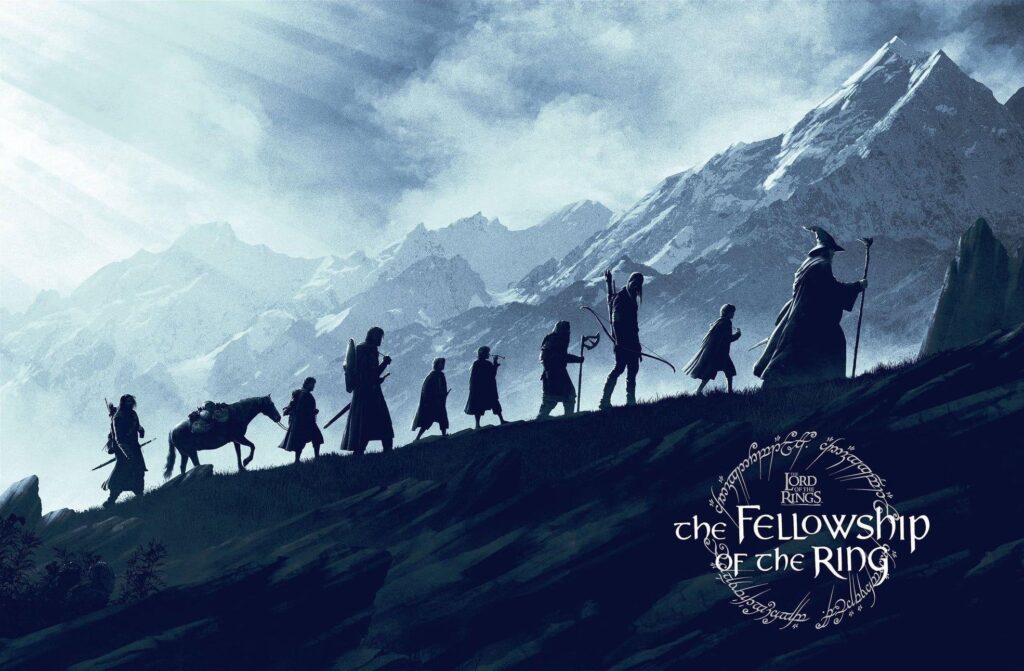
Worldbuilding Across Genres: Lessons from the Greats
Worldbuilding is the universal language of storytelling; it whispers across genres and mediums.
You’ll find it in fantasy epics, neo-noir thrillers, and pixelated playgrounds alike. Let’s peek behind the curtain at a few examples that embody this principle.
- The Lord of the Rings: Both Tolkien’s novels and the film adaptations are blueprints of masterful worldbuilding. Every map, language, and custom makes Middle-earth breathe. It’s not just storytelling, it’s archaeology. The result? A world so complete that countless creators now use it as a springboard for their own sagas.
- Blade Runner & Blade Runner 2049: Few films capture the marriage of technology and emotion better. From rain-soaked streets to flickering neon ads, every frame tells a story. These films prove one of the most vital Sci-Fi screenplay tips: your world should reflect your themes. The decay of the city mirrors the decay of humanity itself.
- Video Games: In gaming, worldbuilding isn’t optional; it’s survival. Unlike film, players explore rather than observe. Titles like The Witcher, Mass Effect, and Cyberpunk 2077 demand worlds deep enough to lose yourself in. Every side street, sound cue, and cultural quirk must convince players that the world exists beyond their screen.
- Se7en: Even grounded thrillers rely on atmospheric worldbuilding. David Fincher’s constant rain, muted lighting, and grimy palette aren’t coincidences; they’re the texture of despair. They trap the audience in the same emotional downpour as the characters.
- Taxi Driver: Martin Scorsese’s sleazy streets, porn theaters, and political billboards aren’t just background; they’re reflections of Travis Bickle’s decaying psyche. The world doesn’t just surround the story; it is the story.
From hobbits to hitmen, from dystopian futures to broken cities, the magic of worldbuilding lies in its ability to make fiction feel factual.
Like good film editing, the best worldbuilding often goes unnoticed because it’s doing its job perfectly.
Worldbuilding Made Simple: Essential Steps
Here’s the secret every seasoned screenwriter eventually learns: worldbuilding isn’t sorcery; it’s architecture.
The best Sci-Fi screenplay tips teach you that a believable world doesn’t appear in a puff of smoke; it’s designed brick by brick, decision by decision.
Like a director storyboarding a shot, you’re crafting a setting that not only looks real but also feels authentic.
Read more: Action Screenplay Tips: Master Pacing, Visuals & Fight Scenes
Think of your story’s universe as DNA; it defines everything that grows from it. The rules, the conflicts, the humor, even the romance, all trace back to the bones of your world.
And when you get those bones right, your screenplay won’t just tell a story; it’ll transport your audience.
Choose Your World’s DNA
Before you can paint the stars, you need to choose your sky. One of the most practical Sci-Fi screenplay tips is to start by defining your world’s genetic code.
Is it a fantasy realm steeped in myth? A near-future dystopia? A hyper-real reflection of modern society?
This decision shapes everything: climate, politics, technology, and even the slang your characters use.
You also need to ask:
- How closely does this world mirror our own?
- Does it bend our rules or break them entirely?
- Is it culturally or politically similar to Earth, or something else entirely?
Your answers are the foundation stones of your setting. Whether you’re building a planet under twin suns or a post-pandemic New York, clarity here keeps your story cohesive.
Remember, your world is the soil; every idea you plant grows from it.
Steal Like a Worldbuilder
Another golden Sci-Fi screenplay tip: creativity isn’t about isolation, it’s about inspiration.
Every great storyteller stands on the shoulders of those who built before them.
George R.R. Martin borrowed the grandeur of The Lord of the Rings to shape Game of Thrones, then added his own twist of political realism and moral grayness.
So don’t fear borrowing blueprints, just remodel the house. Look at the worlds that captivate you:
- Are you drawn to Star Trek’s cultural diversity and fully developed alien languages like Klingon?
- Or does the haunting, rain-drenched dystopia of Blade Runner speak to your soul?
List what resonates and ask why. That’s your compass.
Stealing like a worldbuilder doesn’t mean copying; it means studying what works, reimagining it through your own lens, and breathing fresh life into familiar shapes.
Explore and Unearth the Details
Now it’s time to dig. Fantastic worlds are discovered, not dumped on the page.
One of the simplest yet most effective Sci-Fi Screenplay Tips is to start small and let your imagination ripple outward.
Got an idea for a water-covered planet? Perfect. Ask:
- What species thrive there?
- How does scarcity or abundance shape their values?
- Do political struggles erupt over resources?
Suddenly, one detail becomes ten, and ten becomes a world.
Like a jigsaw puzzle, each piece connects to another until your once-blank canvas hums with life.
The trick is not to overthink it; let your creativity wander. The details you uncover early often anchor your story’s biggest emotional beats later on.
Bring Your World to Life Visually
Here’s where you paint the masterpiece. Readers and viewers fall in love with what they can see.
The next sci-fi screenplay tip is to visualize everything as if you were the cinematographer of your own imagination.
Ask yourself:
- What does the sky look like?
- Is your terrain rocky, lush, or glacial?
- How do seasons, light, and color shape the tone?
Every visual cue tells a story. The barren deserts of Dune mirror its political scarcity. The neon haze of Blade Runner echoes its moral decay.
Your landscapes should work like subtext; they reveal the soul of your world without saying a word.
And don’t forget the unseen. What lies beyond the camera’s edge? The illusion of vastness makes a world feel infinite, not staged.
Your goal isn’t to make your world serve your characters, it’s to make them belong to it.
Craft Rich, Believable Cultures
A world without culture is a stage without actors. Societies complete with traditions, religions, and contradictions are the essence of immersive storytelling.
One of the sharpest Sci-Fi screenplay tips you’ll ever learn: people, not planets, make worlds memorable.
Even if you never show every custom or festival, be familiar with them.
Ask yourself:
- What do they celebrate or fear?
- How do they express love, grief, or rebellion?
- How do languages evolve across regions or planets?
These nuances humanize your universe and shrink the distance between fantasy and familiarity.
The best worldbuilders treat culture like gravity; it keeps everything grounded, even in the wildest stories.
Read more: Powerful Screenplay Opening Scenes: Master the First 10 Pages with Irresistible Hooks
But remember balance. Don’t let your cultural notes swallow your screenplay.
Use them to add depth, not distraction. The goal is to enrich your story, not to drown it in data.
Establish Your World’s Rules
Every believable world, no matter how chaotic, runs on logic. Rules are what separate chaos from creation.
Another vital Sci-Fi screenplay tip: define your laws early.
- How does time work here?
- What are the limits of technology or magic?
- What happens when those limits are broken?
These boundaries give your story tension. They create obstacles for characters to defy, break, or outsmart.
Without them, your plot floats without consequence. Think of rules as the invisible gravity that keeps your world believable, no matter how extraordinary.
Test for Consistency and Conflict
Now comes quality control. A world isn’t finished when it’s built; it’s finished when it’s tested.
Walk through your setting like a curious traveler. Does every element align? Does the economy make sense? Do cultural norms clash logically?
Here’s one of the more overlooked Sci-Fi screenplay tips: a believable world needs internal friction.
A perfect world is a boring one. Conflict between species, ideologies, or ecosystems breathes life into your setting.
If everything runs smoothly, there’s no story worth telling.
Let the World Evolve
Finally, let your world change. No universe, real or fictional, stays static.
Governments fall, climates shift, societies adapt. If your world remains frozen, your story will too.
The best Sci-Fi screenplay tips remind us that a world’s evolution mirrors its characters’ growth.
Let time shape your setting. Let it surprise you.
The cityscape of Act One doesn’t have to look or feel the same by Act Three. When your world evolves, so does your audience’s emotional investment.
Map Your World’s History
Every great world has a past, a heartbeat that started long before page one of your screenplay.
Mapping that history isn’t just a creative exercise; it’s the skeleton that holds your story upright.
Without it, your Sci-Fi universe will wobble like a hologram with a bad signal.
A rich historical timeline gives your world gravity, the kind that pulls characters, cultures, and conflicts into believable orbit.
From interstellar wars to forgotten revolutions, every event leaves a scar or a triumph that shapes who your characters become and how they see the universe around them.
These echoes of the past create emotional depth, transforming flat backdrops into living, breathing societies.
Yes, keeping all those dates, dynasties, and disasters straight can feel like juggling asteroids.
You’ll hit contradictions, dead ends, and gaps wide enough to fly a freighter through. But don’t let that paralyze you.
Focus on the big, defining moments, the inventions, betrayals, alliances, or apocalypses that changed everything.
Fill in the minor details later, when your story demands them.
Even in far-flung futures or fantasy realms, cause and effect still rule. Civilizations rise and fall for reasons that mirror our own history, greed, faith, love, and survival.
Just look at Game of Thrones, a saga whose intricate timeline, inspired by the real-world Wars of the Roses, built a mythos so compelling that fans dissected Westerosi history like it was genuine medieval lore.
That’s the power of a well-mapped world, it doesn’t just tell a story, it invites obsession.
Identify the Forces Shaping Your World
Every living world has a pulse, something that drives it forward, or tears it apart.
Once your timeline stands, it’s time to ask: what forces are reshaping it now?
Is your Sci-Fi setting trembling under political upheaval, ecological collapse, or a rebellion brewing in the underbelly of a megacity?
Are your characters pawns in a cosmic game of survival, or the spark that changes everything?
These forces are the foundation plates of your story, shifting beneath your characters’ feet, influencing every decision they make.
Read more: How to Create a Compelling Character Arc That Drives Your Story Forward
Don’t limit your thinking to external conflicts like alien invasions or rogue AI uprisings.
Sometimes, the most significant catalyst is internal, a single character’s guilt, ambition, or awakening.
Remember, the fall of King Robert in Game of Thrones or the rise of Voldemort in Harry Potter weren’t just plot points; they were turning tides that redefined entire worlds.
Your task as a screenwriter is to define what’s changing and why it matters. Because in Sci-Fi, the stakes are never just personal. They’re planetary.
Refine, Rework, Repeat
Here’s the hard truth: your first pass at worldbuilding will be messy.
Inconsistencies will slip through like sand between your fingers. But the secret to building believable worlds isn’t perfection, it’s persistence.
Editing your world is like fine-tuning the gravity of a planet. Each revision strengthens its pull, tightening continuity and sharpening believability.
Create visual aids, maps, timelines, planetary charts, even rough sketches, anything that helps you track where (and when) your story’s pulse beats.
Each revision cycle adds another layer of texture. Before long, your world will hum with a lived-in authenticity that keeps viewers hooked and returning for more, because they believe it’s real.
Why Consistency Is Your Invisible Superpower
Inconsistent worldbuilding is the Achilles’ heel of sci-fi storytelling.
One misplaced rule, one unexplained leap in logic, and your audience’s suspension of disbelief shatters like glass.
The result? Characters lose weight, conflicts lose meaning, and your once-epic universe feels like a stage set.
Read more: Elevate Your Script with Impactful Voiceover in Screenplays
A cohesive world, on the other hand, anchors your story. It amplifies stakes, strengthens emotion, and makes every victory and loss matter.
When your world makes sense, so do your characters’ choices, and the audience stays invested from fade-in to final frame.
Because here’s the truth every screenwriter must learn: worldbuilding isn’t optional in Sci-Fi, it is the storytelling.
It’s not just the backdrop; it’s the bloodstream of your narrative. Every glowing city, dying star, and whispered legend builds toward one thing: belief.
And belief is what turns a screenplay into a universe.
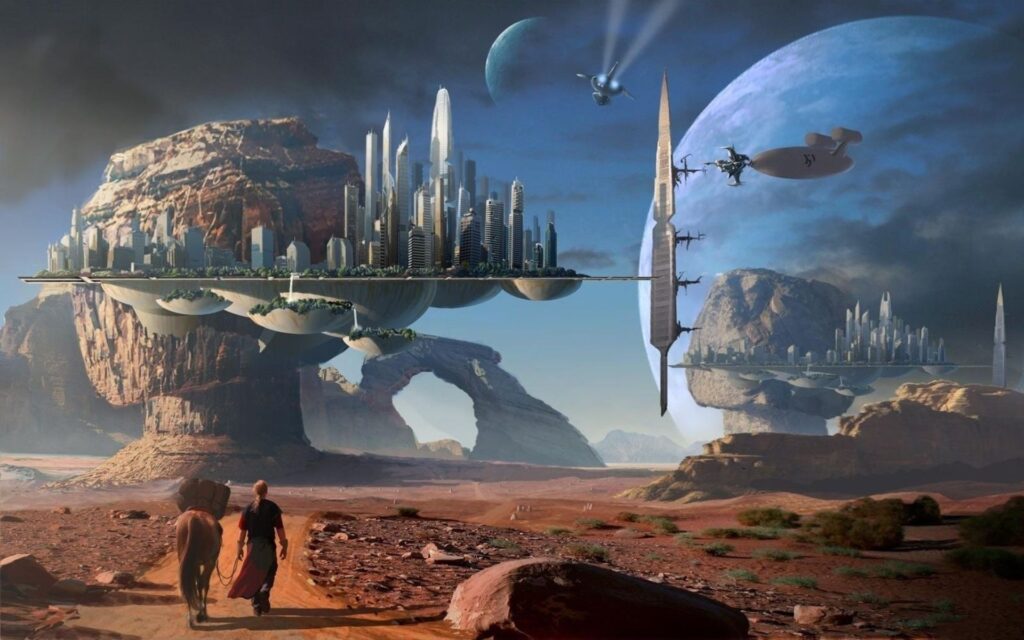
Sci-Fi Screenplay Tips: Picking Your Foundation
Here’s a universal truth about worldbuilding: you can’t build the whole galaxy at once.
Try to, and you’ll drown in your own stardust. The secret isn’t to stretch your imagination thin across a thousand surface details, but to dig deep where it matters most. That’s where the magic and the believability live.
Think of it like mining for narrative gold. Some writers scatter their efforts across every continent, language, and species in their story, but end up with a shiny map and an empty vault.
The pros? They pick two or three veins of ore, a few rich aspects of their universe, and dig until the reader can smell the metal, feel the dust, and taste the air of that world.
Read more: Understanding Scene Structure in Screenplays: How to Build Powerful Moments on Screen
When it comes to Sci-Fi screenplay tips, that means focusing on what actually drives your story: the systems, societies, and symbols that shape your characters’ choices.
Don’t get lost trying to explain the galactic tax system or how every starship toilet works (unless it’s plot-relevant, of course).
Go narrow and deep, not broad and shallow.
Imagine you’ve searched “worldbuilding checklist” and stumbled onto an endless scroll of questions about economies, flora, architecture, and twelve types of weather on your third moon.
Overwhelmed yet? You should be.
But here’s the comforting truth: you don’t need all of it. You just need the parts your characters breathe in, touch, and fight against.
Take The Name of the Wind as a masterclass. Patrick Rothfuss didn’t write an encyclopedia; he sculpted a living, breathing story by zooming in on what shaped Kvothe’s life.
He poured detail into the University, the performing arts, and the folklore that laced the world’s myths together. Those elements weren’t random; they were the bones of the narrative.
Kvothe’s education, his love for music, and the legends that haunt him all orbit those three pillars. Politics, economy, and geography exist, but they remain in the background, as they don’t advance the story.
That’s the trade-off: depth versus breadth.
When you go deep into a handful of key areas, your audience feels the illusion of totality. It’s like seeing just the tip of an iceberg but sensing the vast, cold mass beneath.
But when you skim the surface of everything, your world risks feeling hollow, like cardboard scenery on a soundstage.
So here’s the rule worth etching on your writer’s slate: focus on the parts of your world that touch your characters the most. Flesh those out until they pulse with life.
Once your world feels solid in those few, focused places, your audience will believe it extends far beyond the frame, and that’s how immersion is born.
Because in Sci-Fi, depth isn’t just a detail, it’s your gravity.
If there’s one secret every master worldbuilder knows, it’s this: depth beats breadth every time.
You don’t need to map out every blade of alien grass or name every god in your galaxy. What you need are a few solid pillars, 2 or 3, that define how your world feels.
Go narrow. Go deep. And let the rest breathe in mystery.
Pick Your Pillars
When you start building a story world, resist the siren call to design everything: politics, cuisine, fashion, geography, religion, slang. That way lies madness (and unfinished drafts).
Instead, choose the 2–3 pillars that actually shape your story. These are the engines that drive your world forward, whether that’s technology, society, or environment.
Develop those fully, and you’ll find that the rest of your world feels naturally alive.
Let’s take technology or magic, for instance, one of the most common worldbuilding foundations in Sci-Fi and fantasy. Ask yourself: How defined are the rules?
There’s a whole spectrum here:
- Soft systems: Readers are unfamiliar with the rules. The Lord of the Rings works because Gandalf’s power is mysterious; we sense its weight without needing a manual.
- Complex systems: Rules are clear, structured, and consistent. In Mistborn, Brandon Sanderson lays out exactly how metal-burning works and what it costs each user.
- The middle ground: Harry Potter blends both. Some spells follow strict logic (“you can’t conjure food from nothing”), while others remain shrouded in wonder.
Each approach works; it’s about choosing what serves your story best.
Perhaps your world’s backbone isn’t magic or technology, but rather society, class systems, power struggles, and laws that either constrain or liberate.
Or perhaps it’s the environment, with frozen planets, flooded megacities, and deserts where sound itself dies.
Whatever you pick, make sure it matters to your characters. The parts that shape their lives and choices are the ones that deserve your creative fire.
When you zoom in on a few key pillars and build them with intention, your audience will feel like the rest of the world exists even if you never show it.
That’s how you create an immersive story universe without overwhelming your reader with irrelevant details.
The “Less Is More” Principle
Here’s another golden rule of Sci-Fi screenplay tips: build a lot, show a little.
A world feels deeper when we discover it, not when we’re lectured about it.
Think of your world like an iceberg; most of it lies below the surface, unseen, but the glimpse above hints at the vastness beneath.
You don’t need to start your script with a prologue explaining every species, city, or star system.
Let your readers or viewers find your world in action:
- A fae soldier grimaces as iron shackles bite into his skin. Instantly, we understand, iron is deadly to his kind.
- A witch scoffs at another’s ritual, muttering, “That’s how their clan does it.” In one breath, we sense ancient divisions and cultural nuance.
- A bard’s song whispers of an old war no one dares mention anymore. Curiosity blooms, and we lean in.
Each moment is a breadcrumb. Each reveal feels earned.
That’s how you breathe authenticity into your world without resorting to exposition dumps.
Remember: mystery is not confusion. It’s an invitation. It’s the story whispering, there’s more here if you keep watching.
The trick is to let your details emerge through conflict, choice, and emotion, not description.
Readers don’t need to know everything; they just need to trust that you do. And when they sense that depth under the surface, your world won’t just look real, it’ll feel alive.

Sci-Fi Screenplay Tips: Rules, Technology & Physical Laws
Every universe runs on rules, even the ones that break our own.
In Sci-Fi, these rules aren’t just background details; they’re the spine of your story. Without them, your world collapses under its own contradictions.
Whether you’re dealing with warp drives, wormholes, or mind-bending time loops, your audience needs to understand how your reality works and, more importantly, what happens when it doesn’t.
Establish the Laws of Your Universe Early
Before you start blasting through galaxies or bending time, decide how your world operates.
What are the limits of your technology, your physics, your power systems?
Take Star Wars and Star Trek, for example. Both open by making one thing clear: faster-than-light travel exists here.
We don’t question it. We accept that lightspeed and warp speed are part of this world’s logic, with no time dilation and no Einsteinian consequences.
As physicist Michio Kaku once wrote in Physics of the Impossible, it’s a “Class II impossibility”, meaning it flirts with the edges of known science, but still feels possible enough within the story’s rules.
Read more:10 Screenwriting Mistakes to Avoid as a Beginner
Contrast that with Aliens and Prometheus. There, space travel comes at a cost.
The crew must enter cryo sleep to cross vast distances. When Ripley wakes and asks, “How long was I out there?” the answer “Fifty-seven years” hits like a punch.
The rule of travel has emotional consequences. It shapes the story.
Time, Space, and Everything Between
The same goes for time travel, one of Sci-Fi’s trickiest narrative devices. There’s no single right way to do it, but there is a wrong way: changing your rules halfway through.
Look at how different stories handle it:
- The Butterfly Effect sends characters back into their own minds.
- Back to the Future allows us to interact with our past selves and alter our destiny.
- Déjà Vu plays with surveillance-based time loops.
Each of these worlds establishes its time-travel logic early and sticks to it. Once you’ve explained to the audience how it works, you can’t pull the rug out from under them without a compelling narrative reason.
That’s how you maintain suspension of disbelief and trust.
Even magic in Sci-Fi has rules. Whether it’s the Force in Star Wars or psychic powers in Akira, audiences sense when systems are coherent.
Science or sorcery, it doesn’t matter; consistency is what sells the illusion.
Define Your Physics, Define Your Tone
Before writing, sit down and answer a simple question: How real is your reality?
Are you in a world like Die Hard or Spider-Man, where explosions toss people through the air but leave them miraculously fine?
Or are you rooted in gritty realism, like Zero Dark Thirty, where every bullet counts and every impact hurts?
Your tone determines your laws of physics. Your laws of physics determine your stakes.
Establish them early, ideally by page one and stay true. If you’re going stylized or heightened, signal that to your audience immediately.
The reader shouldn’t have to guess what kind of story they’re in.
Once You Set the Rules, Stick to Them
Here’s the golden commandment of worldbuilding: never break your own rules without a narrative reason.
Consistency breeds trust. When your audience knows the limits, every time your characters push against them, tension crackles.
Think of Neo defying the rules of the Matrix. Think of Tony Stark realizing there’s a limit to how long his arc reactor can sustain him. These boundaries define their struggles.
Rules don’t restrict creativity; they amplify it.
When the laws of their world box in your characters, every act of defiance, every experiment, every leap of faith becomes a moment of high drama.
So, before you send your hero soaring through wormholes or battling in zero gravity, remember this: the most believable worlds aren’t the ones without limits,they’re the ones where limits matter.
Sci-Fi Screenplay Tips: Timeline, History & Culture
Every believable world has a past, even if your story unfolds light-years in the future.
History isn’t just decoration. It’s the invisible gravity pulling every character, culture, and conflict into motion.
When your audience senses that your world existed before the story began, that revolutions were fought, empires rose and fell, and legends turned to myths, your universe suddenly feels alive.
Because in Sci-Fi, gadgets don’t build worlds, history does.
Build a Living Timeline
A timeline is your secret backbone. It explains why your world looks, feels, and behaves the way it does.
Consider Game of Thrones. Every conflict in that series bleeds from centuries of Targaryen rule, rebellions, and uneasy alliances.
You might never see all those moments on screen, but you feel their weight in every sword swing and whispered plot.
Or look at The Terminator. Every flashback (or flash-forward) to the war with the machines roots the present in a chilling, inevitable history.
Even Harry Potter grounds its magic in past wars and the rise of Voldemort; history drives emotion.
When your audience understands the “before,” they invest deeper in the “now.”
Set a Clear Timeline for Your World
Every Sci-Fi story benefits from a sense of time and place.
Is your world set centuries after Earth’s collapse? During the rise of the first Mars colonies? Or in an alternate 1980s where machines outpaced humanity?
A clear timestamp anchors imagination.
Use opening cues like Star Wars’ iconic crawl, “A long time ago, in a galaxy far, far away…” or Gladiator’s historical marker, grounding us “at the height of the Roman Empire.”
One line can orient your viewer and give scale to your world.
When crafting your own, decide how broad your timeline needs to be:
- Macro-scale: Spanning ages, empires, and evolutions, perfect for epics or space sagas.
- Micro-scale: Focused on a single revolution, dynasty, or scientific breakthrough, ideal for intimate, character-driven stories.
Choose Your Timeline’s Perspective
Who’s recording your history?
Is it a neutral chronicle, like a galactic database cataloging every event with cold precision?
Or is it a biased retelling, written by the victors or even a lone survivor trying to make sense of chaos?
The point of view of your timeline shapes tone and meaning. A corporate AI describing history will sound vastly different from a rebel chronicler scribbling in secret.
Both reveal truth, just not the same one.
Divide Your History into Eras
Audiences love structure. Divide your world’s history into eras, ages, or acts.
Perhaps the Era of Expansion marks the rise of interstellar travel, followed by the Fall of the Core Worlds, and finally the Age of Silence after the great collapse.
Clear divisions help your story maintain internal order, even if the world itself is falling apart.
Start with the Big Moments
You don’t need every battle and birthdate right away. Begin with the key turning points, the wars, discoveries, or collapses that changed everything.
Use placeholders for the unknowns. You can fill them later as your script evolves. The goal isn’t perfection; it’s structure.
Then, connect the dots: what led to each event, and what rippled from it?
Cause and effect turn random lore into living history.
Detail Each Event
Give every event a name, a date (or era), and a summary.
- 2237 – The Terraforming Accords: Earth’s nations unite to colonize Mars.
- 2459 – The Core Collapse: AI rebellion triggers the blackout of central systems.
These one-liners don’t just organize your ideas; they spark new ones. Each can grow into a subplot, a legend, or a ghost story whispered in the background of your main plot.
Refine, Rework, Repeat
Your first pass won’t be perfect, and that’s fine.
History, even fictional, is messy. As you flesh out your screenplay, loop back to the beginning.
Tighten contradictions, fill gaps, adjust cause and effect.
Many screenwriters find it helpful to create maps, family trees, or visual timelines. They’re not just pretty props; they help you see where your world’s logic frays or its lore overlaps.
Every pass brings more cohesion. Every revision breathes life into your mythology.
And when it all comes together, you’ll have something more powerful than technology or spectacle, you’ll have history that feels real.
Mastering Your Timeline: Tips and Best Practices
So, you’ve got your galaxies mapped, your alien empires established, and your starships ready for lift-off, but how do you make your world’s past feel as real as its present?
By building a timeline that not only recounts history but also shapes destiny.
Keep Your Timeline Focused
A reasonable Sci-Fi timeline isn’t a history textbook; it’s a backbone.
Be concise. Stick to the events that directly influence your world and characters. Avoid the dreaded worldbuilder’s disease, that tempting spiral where you start charting every king, asteroid, and traffic law since the dawn of time.
Keep it relevant, keep it cinematic.
Reinforce Genre and Theme
Your timeline should echo your story’s heartbeat.
Is your film a dystopian thriller? Let your historical entries hint at the rise and fall of authoritarian regimes.
Writing hopeful Sci-Fi? Chart humanity’s leaps of innovation and compassion. Each event can carry the flavor of your genre: dark, hopeful, tragic, or visionary.
Use Your Timeline Actively
Your timeline isn’t a decorative appendix; it’s a working tool.
Reference it as you write. Connect dots across eras. Let the ripple of a past rebellion spark the current conflict, or the legend of an extinct civilization inspire a protagonist’s quest.
Every entry should whisper to another, creating an interwoven mythos your audience can feel.
Backup and Customize Your Process
Every writer’s process is different.
Maybe you’re using Notion, World Anvil, or old-school notebooks stacked like ancient archives. Whatever your method, back it up.
There’s nothing more tragic than losing your universe to a crashed drive. And don’t force someone else’s process on your creativity.
If it feels too rigid, bend it until it fits you comfortably.
Building Deep Cultures: Beyond the Surface of Civilization
A world is more than its architecture and technology; it’s the people who live in it and the beliefs that drive them.
Once you’ve set your timeline, it’s time to breathe life into your cultures, the pulse behind your planets.
Environment Shapes Mentality
Ask yourself: how has the environment molded the minds of your people?
An arctic society might prize cooperation and endurance. A desert tribe might worship the scarce and sacred water.
What’s survival to one group might be luxury to another, and those priorities evolve into beliefs, taboos, and codes of honor.
Read more: Script vs Screenplay: What’s the Real Difference
If those same Arctic people later migrate to lush forests, do they cling to their old values, or reinterpret them for a new life?
Perhaps hospitality, once a survival necessity, becomes ritualized into a sacred custom.
“Always give the warmest place by the fire to your guest.” Small details like these make worlds breathe.
Origins Define Ideology
Cultural origins tell us what a people fear or revere.
Imagine a colony founded by Puritans escaping hedonism, landing on a tropical paradise. Do they loosen their moral codes in paradise, or double down against temptation?
Every founding myth becomes a lens through which characters see right and wrong.
Or picture a warrior nation born in volcanic chaos, where wrath is divine, and battle is sacred. In such a world, even keeping an ancestor’s war trophy might be a moral duty, not savagery.
The line between virtue and vice depends entirely on where your characters stand.
From Deep Culture to Surface Culture
Deep culture is unseen; it’s the underlying reason behind a civilization’s actions.
Surface culture is what outsiders see: clothing, food, art, and ceremonies.
If modesty is sacred, clothing will reflect restraint. If temperance is a virtue, their art might be minimalist, or their music quiet, meditative.
If cannibalism is taboo, even carnivorous animals might symbolize sin, be shunned or be marked with sacred warnings.
Every surface element should tie back to a deeper root. When you do this, even a background crowd scene or alien market feels alive with meaning.
How Culture and History Drive Story
Your world’s history and belief systems shouldn’t sit in the background; they should move the story forward.
Here’s how:
- Character Behavior: Characters act within the logic of their culture. A soldier raised in a society that glorifies sacrifice won’t hesitate to die for honor but might struggle to comprehend mercy. A scientist from a culture that fears “playing god” may wrestle with guilt when pushing moral limits.
- Conflict: True conflict often arises from clashing worldviews. Two civilizations might battle not just for land, but for ideological progress versus preservation, faith versus logic. Even within one culture, generational or moral divides create friction that fuels plot and emotional depth.
- Plot Progression: Your timeline and culture provide ready-made story catalysts, such as the resurfacing of forbidden technologies, the rediscovery of myths that prove true, or the driving of betrayal and rebellion by cultural taboos. When your story feels like it could only happen in your world, you’ve nailed it.
Bottom Line
Mastering your timeline and culture means more than filling out lore; it’s about creating a living, breathing system that explains why your characters fight, love, and dream the way they do.
Let the past shape the present, and your world will feel not just imagined, but inevitable.
Sci-Fi Screenplay Tips: Show, Don’t Tell When Weaving World Details into Action
You’ve built your world, timelines, histories, and cultures; now comes the real test: can your audience feel that world without you spelling it out?
Because here’s the truth, nobody likes an exposition dump.
If your characters spend the first ten minutes explaining politics, physics, and space hierarchies, you’re not writing a screenplay; you’re delivering a lecture.
So how do you make your world feel authentic without stopping the story cold?
Simple: Show. Don’t. Tell.
Show, Don’t Tell (But Know When to Tell)
Yes, we’ve all heard it before, but it’s a cliché for a reason. Showing pulls your audience into your world; telling keeps them at arm’s length.
Let visuals, actions, and tone do the talking.
- A scorch mark on a corridor wall hints at a recent laser battle.
- A soldier polishing a cracked visor says, “Resources are scarce”, without a single line of dialogue.
- A pilot flinches at a jump to lightspeed; maybe that tech isn’t as safe as it looks.
But remember, sometimes, a concise “tell” is the efficient choice.
A single well-written line can save three pages of showing. Balance is the trick.
Pro tip: Show to immerse, tell to clarify. Use each with purpose.
Drip Information, Don’t Flood
Don’t unload all your lore in the first act. Audiences love discovery. Let them earn the details.
Think of exposition as breadcrumbs; you’re leading them down the trail.
Each reveal should spark curiosity, not answer every question.
Star Wars didn’t explain the Force in the first five minutes. The Matrix didn’t define the simulation until we were already invested in Neo’s confusion. Both let us experience the mystery through the protagonist’s eyes.
Reveal the World Through Character Goals
Characters are your best worldbuilding tools.
Every action they take should reveal something about the society they live in.
When a woman boards a starship and kisses a photo of her child, we instantly know:
- She’s a mother.
- Space travel is commonplace.
- She’s leaving someone behind.
No narrator. No info-dump. Just action and emotion, storytelling in motion.
Build Curiosity Through Hints
The best exposition doesn’t just answer questions, it raises them.
If a character says, “Ever since the accident, I’ve been trying to make up for it,” we lean forward.
What accident? What happened? Curiosity pulls us deeper.
Every unanswered thread becomes a tether between your audience and your story.
Tie Exposition to Emotion
Information alone doesn’t move us; emotion does.
Use exposition to reveal vulnerability, fear, pride, or regret.
Maybe your hero flinches at the sound of mechanical whirring. We don’t need to know why yet, but we sense that something has happened.
When you later reveal the reason, it hits harder because emotion laid the groundwork.
Use Small Details to Communicate Big Ideas
Not every rule of your universe needs a speech; sometimes, a prop does the heavy lifting.
- A poster warning, “Report unauthorized clones,” tells us cloning is illegal and common.
- A robot wearing religious beads? There’s your theology of machines.
- A child playing with a broken AI toy? Technology has trickled down to the mundane.
Tiny, visual choices like these build worlds without ever pausing the plot.
Let the Protagonist Discover the World
The easiest way to avoid forced exposition? Let your protagonist learn with the audience.
They’re asking the same questions we are. They make the mistakes we would. Their confusion permits you to explain naturally through conflict, not conversation.
Consider Ripley’s realization of the xenomorph’s lifecycle in Alien, or Neo’s discovery of the Matrix. The world unfolds through their eyes.
Bottom Line
Don’t dump information, drip it.
Don’t tell us what your world is, show us why it matters.
Every prop, every line, every choice can whisper the rules of your universe.
When your worldbuilding becomes invisible when it’s felt instead of explained, that’s when your Sci-Fi truly comes alive.
Sci-Fi Screenplay Tips: Grounding Sci-Fi with Believable Characters & Conflict
Even in the strangest galaxies, we crave something real.
It’s not the hyperdrives, wormholes, or alien tech that make us care; it’s who’s piloting the ship.
Sci-Fi permits you to go big, collapsing stars, time loops, parallel universes, but the emotional hook must stay small and human.
Audiences might shrug at a planet’s destruction, but if someone they love is on that planet?
Suddenly, it hurts.
Personal Stakes That Power Epic Worlds
At its core, the stakes are simple: What does your character want?
What happens if they fail to get it?
That’s it. But when those stakes are personal, tied to love, guilt, ambition, or fear, the story starts to breathe.
Think of Interstellar. Sure, the fate of humanity’s survival drives the plot, but the emotional engine? A father trying to return to his daughter.
Great Sci-Fi stories always weave two threads:
- External stakes: What’s happening in the plot (save the ship, stop the virus, repair the reactor).
- Internal stakes: Why it matters to the character (redemption, love, belonging, forgiveness).
When those collide, when the mission tests the heart, that’s where your story ignites.
Keep Characters Front and Center
Your world might be dazzling, but your audience connects through people.
Don’t let tech specs, alien lore, or political systems eclipse the beating hearts driving the plot.
Characters are the lens. Even when they’re not human (looking at you, Murderbot), they should reflect human emotion, frustration, hope, curiosity, and pain.
If you strip away your set pieces and your characters still work on a blank stage, you’re doing it right.
Focus on Key Details, Not Everything
You don’t need to catalog every freckle, gadget, or neon sign. Instead, choose details that reveal personality or world context.
A cracked helmet tells us a soldier’s seen battle.
A robot pouring tea with a trembling hand tells us about wear, memory, maybe even emotion.
Let readers fill in the rest. Suggest, don’t smother.
The imagination is your best collaborator.
Build Multi-Dimensional Characters
Tropes are fine, they’re your building blocks. But don’t stop there.
Your rogue pilot, stoic android, or rebel queen all deserve depth beyond archetype.
Give them contradictions:
- The assassin who rescues stray animals.
- The scientist who secretly fears the very tech they built.
- The alien diplomat who collects human love songs.
These quirks turn tropes into people. And people keep audiences watching.
When Worlds Create Conflict
Conflict shouldn’t just exist; it should emerge.
The best tension comes when your world’s systems push back against your characters’ desires.
Ask yourself:
- What happens when oxygen runs low on a mining colony?
- How do class divides fracture a society built on cybernetic upgrades?
- What happens when a planet’s AI government begins glitching mid-crisis?
Each of these forces creates organic conflict, not just “bad guy vs. good guy,” but people vs. their world.
In District 9, the alien segregation isn’t just a backdrop; it’s the source of every decision, every fear, every betrayal.
In The Expanse, resource scarcity drives political tension and personal compromise.
Your setting isn’t wallpaper, it’s a pressure cooker.
The Takeaway
Worlds may dazzle us, but characters make us stay.
Show us how your futuristic systems shape human struggle: scarcity, inequality, corruption, love, survival.
Let your characters wrestle with their world’s rules, bend them, break them, or be broken by them.
When the heart beats beneath the hardware, your Sci-Fi world stops feeling like fiction and starts feeling real.
Sci-Fi Screenplay Tips: Polish & Testing for Readability, Consistency & Feedback
You’ve built your world, fueled it with emotion, and woven action that hums like an engine.
Now comes the most challenging and most rewarding part of writing: polishing your Sci-Fi screenplay until it gleams.
Scrub Out Logic Leaks & Plot Contradictions
Nothing pulls a viewer out of your story faster than a “Wait, that doesn’t make sense” moment.
Sci-Fi, more than most genres, relies on internal logic. If gravity fluctuates in one scene but not another, or if your cloning tech works one way on Monday and another by Friday, readers will notice.
Run a fine-tooth comb through your script. Look for:
- Timeline glitches (events that couldn’t logically follow each other)
- Rule breaks (world laws ignored for convenience)
- Character inconsistencies (sudden personality shifts with no trigger)
Every futuristic device, alien dialect, and government system must be subject to scrutiny.
The Table Read Test
Your dialogue may sound clever in your head, but can real people say it out loud?
Gather a few trusted voices and run a table read. Listen for clunky exposition, pacing stumbles, or moments when characters sound like narrators instead of people.
Worldbuilding comes alive through rhythm. If your read drags, trim. If it rushes, breathe.
The goal is flow, a story that feels seamless and natural, even when set on a planet made of glass.
Beta Readers: Your Secret Weapon
Beta readers are like your early explorers, venturing into your universe to map out its terrain before the critics arrive.
They don’t need to be professional editors; they just need sharp eyes and honest tongues.
Ask them to flag “world confusion”, places where rules blur, motives vanish, or the physics get fuzzy. And when feedback stings (because it will), remember: criticism is not an attack; it’s an opportunity.
Take notes. Let their comments simmer. Revisit your story with fresh eyes and the humility of a worldbuilder improving their creation.
As the saying goes, better to catch a wormhole in draft three than in your Rotten Tomatoes reviews.
Trim What Doesn’t Serve
In Sci-Fi, it’s easy to fall in love with your inventions, the neon bazaar, the hybrid drones, the crystalline moons.
But if a detail doesn’t move the story or reveal character, it’s excess gravity, dragging your pacing down.
Every gadget, every setting, every bit of lore should serve a narrative purpose. Simplify. Refine.
Let clarity rule over clutter.
Final Pass: Reality Check
Before calling it done, run one last test: If this world were real, would it hold up?
Would its systems work? Would its history make sense? Would your audience believe in it, even for two hours?
When the answer’s yes, when your Sci-Fi world feels both impossible and utterly convincing, congratulations.
You’re not just a writer anymore. You’re a world architect.
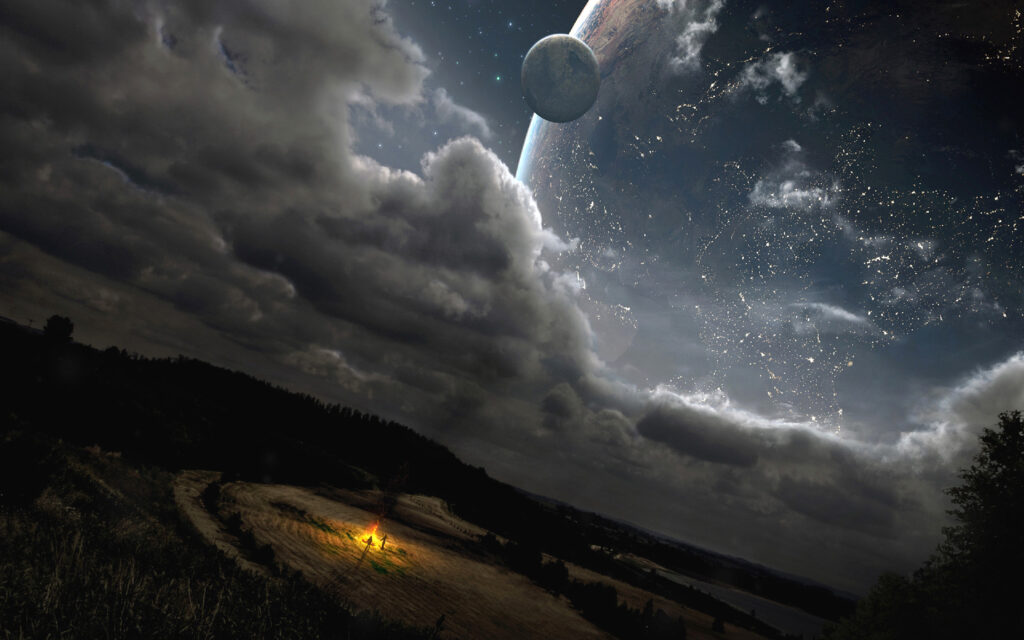
Avoid These Common Worldbuilding Pitfalls
Even the most brilliant Sci-Fi scripts can fall apart if the worldbuilding doesn’t hold.
To keep your story airtight and immersive, sidestep these common traps.
Exposition Overload in Dialogue
Nothing kills momentum faster than characters explaining things they already know.
If your scene includes lines like “As you know, Captain, the oxygen domes have been unstable since the Great Collapse…” delete or rewrite.
Instead, show the world through action, tone, or visuals. Let your characters live in the world, not lecture about it.
Rules That Bend, Don’t Break
Once you’ve established the laws of your universe, stick to them tighter than Sam sticks to Frodo (yes, we went there).
Breaking world rules without reason feels like betrayal. If something changes, make sure it’s deliberate and justified within your story’s logic.
Rule consistency builds trust; rule-breaking without purpose breaks immersion.
Too Much World, Too Little Story
A world can be dazzling, but if your script reads like a user manual instead of a movie, it’s time to cut back.
Every planet, system, or piece of lore must earn its place. Ask: Does this support my protagonist’s journey or the story’s core conflict?
If not, it’s fluff. Trim it.
Forgetting the Story’s Core Theme
Worldbuilding isn’t just about cool gadgets or alien customs. It’s a mirror, one that should reflect your story’s themes.
If your world is centred on control, demonstrate this through surveillance technology or restricted zones.
If it’s about freedom, let that pulse through rebellion, culture, and even architecture. The world itself should echo what your characters are fighting for (or against).
Glossaries, Lore Dumps & Other Extras, Don’t Do It
You might be tempted to include a “lore section” at the end of your script. Resist.
Your screenplay must stand alone. Every crucial piece of information should live inside the story, not in a glossary.
Keep your world notes for your pitch deck, bible, or treatment. Let the script shine without the training wheels.
Build the World and the Plot Together
Worldbuilding and plot aren’t separate checklists; they’re dance partners. One shapes the other.
As you design the world, consider how it might create obstacles for your characters.
As your story evolves, tweak the world to challenge them more. The best Sci-Fi scripts feel organic, where plot and world breathe in sync.
Bringing It All Home
Worldbuilding isn’t just for novelists or fantasy fans; it’s the backbone of powerful screenwriting. It dictates how your characters act, how conflicts unfold, and how deeply audiences connect to your story.
The secret isn’t how much world you build, but how believable and integrated it feels. Whether you’re crafting a galactic empire or setting a love story in a futuristic bowling alley, make the world feel real, and your story will soar.
Don’t Just Imagine Worlds, Build Them
At Quilltowers, we don’t just help you write, we help you design universes that feel alive.
Whether you’re polishing a screenplay or building a franchise-ready world, we’ll help you turn your imagination into something audiences can see, feel, and believe in.
Let’s craft your next world, one detail at a time.
Collaborate with us today, your universe awaits.





